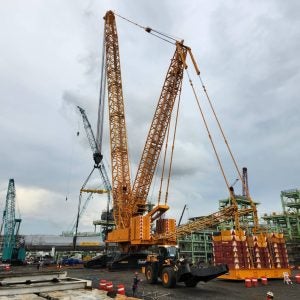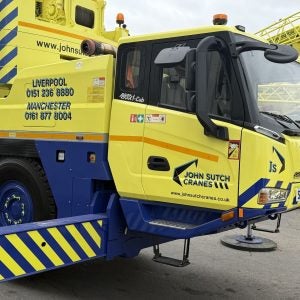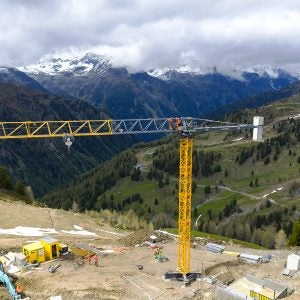?Millenium Developments’ Olympic village consists of 12 towers of heights up to 10 storeys of slipformed cast concrete. The apartments will hold athletes during the games, and then be renovated for permanent residents.
“A typical project like this is phased, with personnel in trade groups working sequentially on a couple of buildings at a time,” says Jeff Lyth, ITC Construction Group director of corporate health and safety, in April 2008. “Here, all the buildings are going simultaneously. We have done excavations, and now are all in the structures, then all will be in interiors and occupancy at the same time. To achieve this, the owner and developer, Millenium, has two prime contractors: MetroCan and ITC. We’re building four parcels, MetroCan is building eight. We have four cranes, they have eight.”
Lyth explains that even such a large number of cranes is more common than it used to be. “Multiple cranes on projects is something that began 10 years or so ago and is increasingly popular. That is what we find we need to reach the tower and all the corners of the site. On these sites, there are multilevel concrete arcades below ground level. In an efficient plan, you need to make sure they don’t overlap too much. Actually they can hinder each other; there is only one crane moving at a time in the worst case. We plan jib lengths to only have as small an overlap as possible.
“On such a fast-track production schedule, we need lifting until the last minute. One project might not be so bad, but we have 12 buildings, not to mention the road and infrastructure. The site is next to the Vancouver seawall, a long public walkway that goes around the city, which was one of the first things to be completed. Two cranes overlap the active walkway to the north of the site. We wanted to zone that area out completely, so the hook, whether loaded or unloaded, would never go that way. We can do that with the anticollision system,” Lyth says.
“Having two contractors on the same site was an aspect of the decision to go with an anticollision system. Fundamentally it was about the number of cranes, the degree of overlap, and the number of overlaps. We have an excellent working relationship with MetroCan. Millennium has a safety consultant as well.” Lyth says that one crane overlapped with five others.
Old-fashioned written protocols were simply not safe enough for the job, Lyth says: “The conventional way for dealing with overlapping cranes, which involves a written protocol, a protocol between crane operators, is a relatively low order of control. Generally occupational safety requires a higher order of control. The highest order of control is elimination or substitution of a risk. Here, that is not practical; we can’t eliminate the tower cranes, or substitute the tower cranes for something else. The hierarchy goes, from top to bottom: elimination, substitution, engineering, administration, PPE. Putting in a system like this engineering control is a higher order.
“We didn’t see a way of getting through the project with the proper level of safety and risk mitigation, and we started looking for anticollision systems. Workplace BC was keen to have the technology tried, because it had not been done before.
Dealer Persha International installed eBuild’s TAC-3000 anticollision system on seven tower cranes on the site. “One of the big benefits of our system safety-wise is bringing these old cranes up to speed; we are giving them LMI functionality. We have had to retrofit every crane with a new limit and potentiometer assembly,” says Kendall Strysick, of Persha International.
Before they could install anticollision systems, they needed to get the cranes up to speed. Like the entire region, the cranes used in the Olympic village site were not new; ‘the west coast of North America is the last stop for a lot of old tower cranes,’ Lyth says. They could not install the TAC-3000 without an upgrade.
Although ITC bought the anticollision systems with Millenium Developments, it does not own the cranes. In Vancouver, cranes are generally supplied by the formworks contractors. “Three of the cranes are owned by Val Coupal of Coupal cranes, on MetroCan parcels. Of our cranes, one is owned by HP, two by Femo, and one is rented by Femo from rental house Tall Crane,” Lyth says.
Lyth says that Worksafe BC kept a close eye on the system installation. “Because this is new, the standard in this jurisdiction is that any modifications to the crane need to be certified by a professional engineer or by a manufacturer. This rule is typically applied to structural modifications. Here the only modifications that we are making are tying into the wiring: slew left, slew right, trolley in and out. But this electrical tie-in still requires an engineer to approve and sign it off, when connected and when disconnected. And also that it needs to remain as a backup-only system.” That last stipulation meant that five of the cranes remained in warning-only mode for most of the build, Lyth says, until an engineer could learn the system well enough to sign it off.
But it was not a total loss, Lyth says. “Merely having the system detect movement and issue visual and audible alerts to potential collision paths was a massive improvement over what was in place prior to that, namely nothing.”
The combination of the expedited schedule on the project with the novelty of the anticollision system meant that the units were only installed on the cranes well after concrete pouring had begun; one building was higher than level four before the TAC-3000 was installed. “The excavation phase was well under way by the time we were brought on board,” Lyth says. “There were a lot of logistics, legislation, budgeting and engineering to do.”
By November, three of the cranes had finished work and were removed.
Lyth says that the seven systems will stay in the area for future projects. “There are a lot of two-three-four crane sites in the area, and I hope it catches on. It will have had a late start in this project, but hopefully it will still create a legacy, and people will use it in the future.”






